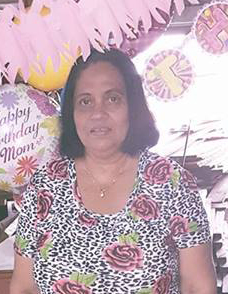The trial of the young man accused of the 2016 killing of Mahaicony businesswoman Bibi Shairoon Nesha Ali heard yesterday that his fingerprints had been found on a wardrobe in a bedroom of the woman’s home where her partially decomposed body was found.
For legal reasons, the name and identity of the accused who was a juvenile at the time, has to be withheld from publication.
The teen who was 14 at the time, is alleged to have murdered Ali during a robbery at her Lot 4 Novar, Mahaicony, East Coast Demerara home sometime between October 15th and 17th of 2016.
Testifying yesterday was fingerprinting expert Inspector of Police Lalbachand Dial who said that he had analyzed a number of latent fingerprint samples taken from the teen, and it was found that his prints matched samples extracted from a wardrobe in one of the rooms of the dead woman’s house.
Defence attorney Bernard Da Silva questioned Dial under cross-examination as to whether the cloth with which the deceased had been bound by her hands and feet had also been dusted for fingerprints.
Apart from saying that such prints cannot be extracted from fabric, he added that the cloth was moist and would have made such an endeavor, even if possible, far more difficult to achieve.
The lawyer then asked him whether his expertise would allow for him to estimate a possible timeframe when the prints on the wardrobe could have possibly been deposited. Da Silva suggested it might have been months prior.
Dial, however, said that while he could not say exactly when the deposit may have been made, it certainly was not months before. He then went on to explain that if this was the case, dust would have accumulated over the fingerprint impression which would have revealed itself during the analysis.
This he said would have also caused some amount of smudging which would have affected the ridge characteristics of the impression for analysis.
He said he believed the impressions to have been made fairly recent to them having been extracted for analysis back in 2016, but did not rule out a further suggestion from counsel that it possibly could have been deposited weeks earlier.
Dial, however, strongly maintained that they could not have been deposited months before.
Also testifying was Detective Lance Corporal Deoraj Ramdehol who recalled putting the allegation to the accused who he said forthwith denied any involvement in the crime.
“Officer, I don’t know nothing bout that,” Ramdehol said the accused remarked.
The Detective said he then told the accused that the police were in possession of a caution statement from a co-accused implicating him and also that his fingerprints had been found at the scene.
In response, Ramdehol said the teen related that his then co-accused “lie pon me. Me nah do dah.”
Meanwhile, to the alleged fingerprint match, the witness said that the accused enquired, “officer, me nah bin deh, suh how me prints gon match?”
Under cross examination Da Silva questioned the detective on whether the police had ever been able to locate a black car reported to have been seen in the area during the time the murder is believed to have occurred.
Ramdehol said that they were unable to locate the vehicle in question and that CCTV footage also yielded nothing of evidential value.
Sister of the deceased, Bibi Mubarak Ali was also among the witnesses testifying yesterday.
She told the court that her now-dead sister and the accused had previous problems and he had threatened to kill her.
This, she said had caused her sister to lodge a report with the Mahaicony Police Station.
She also recalled receiving a phone call from a neighbour of her sister who lived alone, informing her that the businesswoman had not been seen for some time. As a result, the woman said she sent her son to check on his aunt and he later returned with the tragic news which caused other relatives to immediately rush over to the woman’s residence.
Eighteen-year-old Imran Ali would later testify that after arriving at his aunt’s residence and getting no answers to his calls from the gate, he jumped the fence as his mother had suggested once the padlocks were on the gate.
He said that as he made his way to the bottom flat of the two-story house, he was greeted with pungent scent which raised his suspicion and as he pushed the door to the bottom flat he discovered his aunt’s lifeless, swollen and decomposing body lying on the ground.
The teen said that he immediately ran out and back to his home where he raised an alarm.
Mubarak Ali said that when she and other relatives arrived at the scene, they were greeted with the overwhelming odour and her sister’s lifeless body bound on the floor.
Pathologist Dr. Nehaul Singh said his autopsy revealed that Ali died from bleeding of the brain due to blunt trauma to the head.
He told the court that apart from signs of decomposition and her having been bound, her hair had already begun falling out and her eyes and tongue were protruding. He said that her neck was also tied and there were bite marks on her tongue.
The pathologist said his examination also revealed bruising to the interior of her legs and to her genitals which suggested possible sexual assault.
Sergeant Patrick Benjamin, who photographed the scene and the body, tendered the 12 photographs he had taken. They were admitted and shown to the court.
The state closed its case after calling all of its 11 witnesses yesterday.
The matter continues at 9 this morning before Justice Navindra Singh and a 12-member jury at the High Court in Georgetown.






